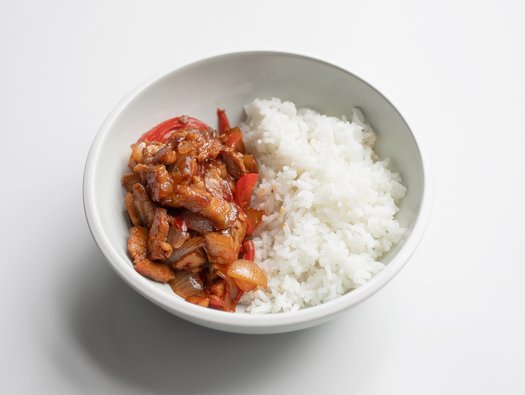Double-cooked pork

Full of flavour but low in salt, this is a quick, low potassium, low phosphate meal.

Full of flavour but low in salt, this is a quick, low potassium, low phosphate meal.
200g pork belly
300g rice
1 large green or red pepper, sliced
1 large onion, sliced
¼ leek (optional), sliced
2 tablespoons vegetable oil
1 tablespoon Toban Djan (chilli bean paste)
3 cloves of garlic, finely chopped
1 tablespoon caster sugar
1 tablespoon reduced-salt soy sauce
Put the pork belly into a saucepan on the hob and cover it with water. Heat the water until it is boiling, then switch off the heat, drain the water and rinse the pork under tap water until it is cool.
Slice the pork into bite-sized pieces. Cook the rice according to the packet instructions.
Slice the onion and pepper into strips, and the leek into small oval shapes. Heat up the oil in a wok/frying pan. Put the Toban Djan (chilli bean paste) into the oil and heat over a low heat
Add the garlic and sliced pork in when you can smell the spicy flavour. Stir-fry for a couple of minutes until the pork is coated in the sauce.
Add the onion, pepper and leek (if using) to the pan. Continue to stir-fry for a few minutes until the vegetables soften.
Add the sugar and soy sauce and cook for another 2-3 minutes until the pork is cooked through. Serve with rice.
The rice is the main source of carbohydrate in this recipe, and the value has been provided for those who have been trained in insulin adjustment.
This recipe is low in potassium and can be enjoyed as part of a low potassium diet when you follow the suggested quantities for all the ingredients and the serving sizes.
This recipe is also low in phosphate, however it still contains phosphate, provided by the pork and rice. If you have been prescribed a phosphate binder, ensure you take them with this dish.
This recipe is low in protein, which makes it suitable for those advised to reduce their protein.
Use a gluten-free soy sauce and chilli paste.
To increase the amount of fibre in this dish, consider using a wholegrain brown rice in place of a white rice. Be mindful that the reduced-salt soy sauce and chilli bean paste are both high salt ingredients, therefore you should measure these carefully to avoid adding additional salt.
This dish is best eaten fresh.
Potassium is a mineral that can build up in your body if your kidneys are not working properly. Some medicines can also increase your potassium levels. Read on for advice to help lower your potassium levels.
You can enjoy a wide variety of delicious and healthy food when you are living with kidney disease. All Kidney Kitchen recipes are analysed and approved by kidney dietitians. Search through our kidney-friendly recipes or filter them by category below.
These tasty wontons are not only a delightful addition to your meal but are also low in salt, potassium and phosphate. Plus they provide a valuable source of protein, making them a nutritious option for dialysis days.
By giving us your email address, you're giving us permission to send you the latest news from Kidney Care UK. Further information about how we protect and use your personal data is available in our Privacy policy. If you would like to change the way we communicate with you at any time please email [email protected]. You can unsubscribe at any time by using the link at the bottom of every email we send.